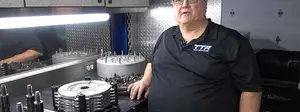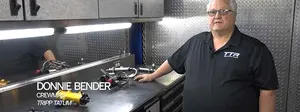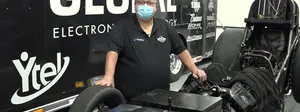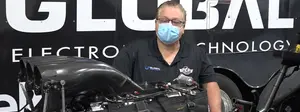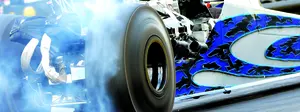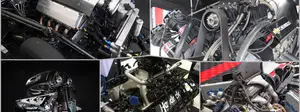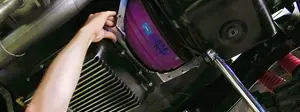

Prepare for success: Tips for getting ready to start your racing season

With every new racing season comes dreams of winning rounds and taking home Wallys. NHRA drag racers have contested for this coveted piece of hardware for decades across a variety of classes. Hoisting a Wally means you’ve been successful competing against the very best in the sport. Most will agree it’s a very special achievement, and no matter your class of racing, winning comes from hard work, a little “racer luck,” and meticulous preparation.
This story is about preparing to win. Every racer “wants” to win, but how many really are prepared to do so? Do you show up and hope to have a good weekend, or are you really ready with the tools to get the job done? Proper prep occurs long before you do a burnout or stage your car for the first round.

• It begins at home, and it involves mental, physical, and mechanical readiness. In simple terms, winning requires a race vehicle that’s ready to go and a driver who’s confident and prepared to race. And we’re not talking about packing a few tools and those burgers to toss on the grill. A winning race driver has analyzed the schedule, the weather, and track conditions. He or she has assessed the competition and has developed a strategy.
• So, if winter looms, turn your downtime into something positive by starting your racing prep now. Chances are your car is apart or at least put away in the garage. Look at your routine for getting you and the car ready. Up your game by getting in a racing state of mind.
• The old adage “proper planning prevents poor performance” is a good place to start. While it happens to the best racers, no one likes to strap the car down after the first round. Preventing poor performance starts with a winning mentality. No matter the sport, successful athletes think like winners. Build confidence by staying in (or getting in) shape. Eat a healthy diet and drink lots of water, especially before and during race weekends. If you feel healthy, you’ll be one step ahead of the competition.
• Vehicle prep is next. It’s hard to win if you have constant mechanical issues, so create a checklist that covers all the important points. You may have items that you check once or twice a year, other things you may go over after each outing. Chart wearable/serviceable items like belts, tires, oil, plugs, valve springs, etc., so you can keep better track of them. Keeping this info handy lets you know when important items like your helmet and harness expire. No one wants to be running around looking for belts when the competition is preparing for qualifying.

• Offseason prep should include more than just the car. Look at your towing equipment, including tie-down straps, trailer tires, hitch, etc. Having everything fresh gives you peace of mind and lets you focus on racing and winning. It sounds simple, but many of these things are often overlooked.
• Believe it or not, one of the biggest hurdles can be found in your own mind. If winning is the goal, your mental game needs to be strong. Confidence is key, so arm yourself with data and knowledge. Read up on the rules and keep notes on your competition. Have a variety of strategies for qualifying and racing. Of course, you’ll need to test these before employing them during competition. So, not only do you need to practice, you’ve got to practice proper technique. Just making runs won’t do you any good if you’re staging inconsistently or you’re not focused on the Tree.
• Mechanical preparation can go from mild to wild. We recommend creating a checklist so you can mark off tasks as you complete them. Start at the front and work your way to the back, noting all the things you’ll need to inspect.
• Few things can be more frustrating than hitting the starter button and getting nothing. With that in mind, the starter is one item worthy of checking every winter. In fact, it’s a good idea to carry a spare.

• Spark plugs are relatively inexpensive, so give them a look before firing the engine after a winter break. Often, you can spot things on the plugs that may indicate a larger issue. Catching something like a leaky head gasket before you fire the engine can save you time and money.

• Inspect all sensors, wiring, and connectors. Corrosion or a bad connector can cause bugs that take forever to diagnose.
• Vibration and harmonics can cause hardware to loosen and ultimately fail. So, it’s a good idea to put a wrench on all hardware, especially bolts that are attached directly to the chassis.
• If your car wheelstands, you may want to inspect the front suspension, including the hardware, steering, A-Arms, etc. Also check your wheelbase and look for bent parts. An annual front-end alignment is also a good idea.

• Stopping is important, so check the rotors, pads, and associated parts.
• Keeping the battery charged is critical, and there are many options for keeping your battery topped off.
• It’s pretty tough to drive the finish line in the offseason, but you can keep your mental game sharp with a practice Tree and physical/mental conditioning.
• Dragsters can take a beating on and off track, so regular chassis inspections are a must. It’s important to remove body panels and look carefully at the welds and tubing.

• The offseason is a great time for a good, old-fashioned carburetor rebuild.
• Regular maintenance should include valve cover bolts, header bolts, intake bolts, belts, fluids, and throttle cables.

• With the car safely jacked up and supported, take a look at all welded and bolted-on components, such as the driveshaft safety loop and transmission crossmember.

• A bad switch or faulty wiring can be a real headache. Take a peek under the hood, dash, and in the trunk and look for corrosion, cracked wires, or worn connectors.
• Winter is a good time to do some fabrication or fix any cracks.
• If you disassemble your car, run some checks once you get everything back together. Make sure the shifter goes through the gears smoothly and that things like the line lock and gauges work properly.

• Bushings can wear over time and cause all sorts of problems, including inconsistent launches and ill handling. Replacing rubber with urethane or Heim joints (when applicable) is a good idea.
• Having the proper tools can make any job easier, this includes cleaners, fender covers, a quality jack, and jack stands.
• After a long season, you may want to pull your engine. A quality engine cradle is a great investment, as it will make it very easy to ship or transport your valuable powerplant.
• Always inspect the valves, along with the valvetrain, piston, rod assembly, and the heads before reassembly.

• Take inventory of your tires and how many runs they’ve accumulated. A fresh set to the start of the year is a great idea.
• It’s also a good time to go over the engine bay, inspecting the unibody, suspension, and wiring.
• Dyno testing is great to baseline an old engine prior to a rebuild or to break in and tune a new mill.
• Don’t neglect your trailer and towing equipment. Inspect tie-down straps, D-rings, tires, and brakes. Additionally, checking the basics on your hauler (belts, coolant, brake fluid, etc.) can save downtime during the season.

• Scaling your race vehicle is great for chassis setup and to help determine if something is bent. Of course, you’ll need a baseline and good notes to spot differences over time.
• Regular checks of the chassis are especially important in high-horsepower cars, especially those prone to tire shake.

























